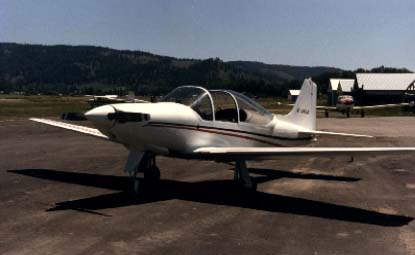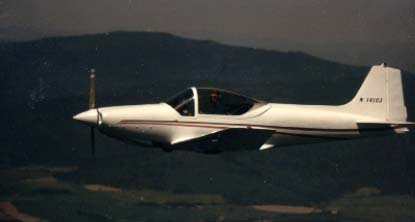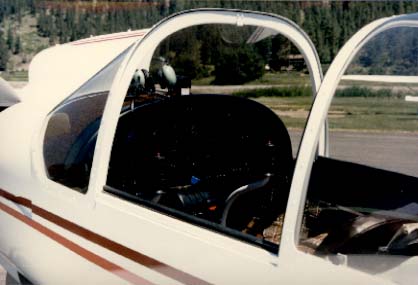Flying the Falco
![]()
Flying the Falco |
|
by John Harns
|
Dear John: If you have the time, I think it would be a good idea if you could write a short thing for our next builders letter. With all those builders out there, there are a lot of guys who hunger to know what it is like to fly a Falco. They've read all the stuff that we have put out and James Gilbert's flight report, but I think many of them would like to also hear the raw, uncut stuff right from the mouth of a guy who built one. Try to put yourself in their shoes and remember all the things you would like to have heard when you were working on your Falco but had never seen one, much less flown in one. Alfred Scott |

There are a lot of reasons why people who build airplanes select certain models, but one look at the Falco says it all. Undoubtedly, the performance specifications may have had influence, but an airplane with the lines, balance and beauty of the Falco just has to fly as well as it looks. I admit the publicity and attendant comments by numerous well-known aviators in the "Flight Report" on the Falco piqued some interest, but it was flavored with a grain of salt. Not until the day of the first ride in Alfred's "Corporate Disgrace" did I realize how true those comments were.
For justification and qualification of my following comments, I have been flying for 40 years; 30 years gratis with the Navy, in everything from J3s to F-14s including all between, mostly single engine.
The first flight in my Falco more than justified all those hours, frustrations and expenses -- besides, it flew better than the "Corporate Disgrace." Acceleration is impressive... not exactly like a Bearcat but not bad for 160 horses. Climb to 10,000' isn't done in 90 seconds like the F-4, but again 500 seconds isn't too shabby for a 4-banger.
Many say that flying the Falco is like flying a little fighter -- that's not totally true, but it's as close as you can come on my pocketbook. Herein lies the Falco's greatest characteristic: it is a pilot's airplane with sensitive, responsive controls. I have flown few planes that have better, more equally balanced controls for quick, agile maneuvering. A Pitts it is not; but for sheer enjoyment, acrobatics in the Falco is a dream.

Visibility in the Falco is unmatched; you are literally sitting on top of the world in its cockpit. For a small aircraft, comfort in the Falco is a pleasant surprise. The cockpit is relatively roomy, better than a 172, and the seats are designed well enough to allow my 1.5 rear end to last over 5 hours. There is virtually no vibration or slipstream/canopy noise or leakage. All controls and switches are exactly where you'd expect them to be. The Sequoia Falco is a quantum improvement over the "factory Falco" -- believe me, I've flown both.
The Falco is an outstanding cross-country machine. In addition to its speed -- I normally file for 190mph TAS and 4-plus-hour legs -- it will carry two with baggage for a month. My bird is fully IFR and in addition to sun has flown in rain and snow with a few limited excursions into thunderstorms and ice. I've gotten airborne, with little degradation in performance, at a density altitude of 6,800' with a full gross load. And it's a lot of fun to brief inquisitive ATC controllers on what a Falco really is. They all are very curious about the Falco, and a lot of them know the bird. They all ask what I've got under the cowl -- especially when I'm truing at 190 mph and grounding at 220 mph with a tail wind.
We recently flew to San Diego -- had a good flight and the Falco performed flawlessly. Most of the trip was IFR, and I found out that it will carry quite a bit of ice. We got into some light rime -- I guess about 1/4", with the windscreen completely iced over -- but we soon got a lower altitude and lost it. It didn't seem to decrease the airspeed or performance. My attitude toward ice is get the hell out of it; it's about the only thing I really fear about flying in the light stuff. On the trip home we got a 4.7 hour leg with 3.5 gallons remaining, because we were bucking a 45 kt headwind right on the nose. We ran the aft tank dry -- I had Pat glued to the fuel pressure gauge -- but it took about 35 minutes after the gauge read empty. It's reassuring to know I've got a good 4.5 hours with IFR reserve.

My only complaint is heat. It was 42°F at 12,000' going over the Cascades. We had longies, boots and gloves, and we survived, but I've got to put some coiled wire wrap in the heat muff to increase the heat transfer.
When we arrived in San Diego Montgomery, a gent was standing there and said "How was the trip from St. Maries, John?" I didn't know him, but it turned out that he was the airport manager and had the tower look up the tail number on their computer to find out what it was, who owned it and from where. It does draw a crowd -- we even had the official photographer from the San Diego Aerospace Museum taking pictures.
For a relatively high performance aircraft, the Falco has no real bad habits. Things happen a little faster than in Wichita stables, and the stall is sharp. It is sensitive -- as you'll find out flying IFR in the soup for an hour without autopilot -- but not overly sensitive. It is subject to lateral trim changes with changing lateral loading, i.e. one passenger vs two, and an aileron trim would be nice. Yet, it is relatively insensitive to longitudinal trim changes as long as you're within CG range. It gets a little "bouncy" in rough air but not uncomfortable and well within the G loading. You really have to work at it to screw up a landing in the Falco. The panel is professional as well as functional with the only bitch that the warning lights should be on a dimmer for night flying.
To sum it up, I don't know where else you can get so much in one package as in a Falco. Put that in your pipe and smoke it!
|
John Harns is a retired Navy Captain who flew everything from Bearcats to F-14s -- off carriers, of course. John built his Falco and flew it in 1985. Since then, John has put a lot of time on the Falco and has flown it all over the U.S. Much of the time has been on instruments -- he once picked up 3/4" of ice and on another occasion "indoctrinated" his poor wife, Pat, to thunderstorms. |
|
|